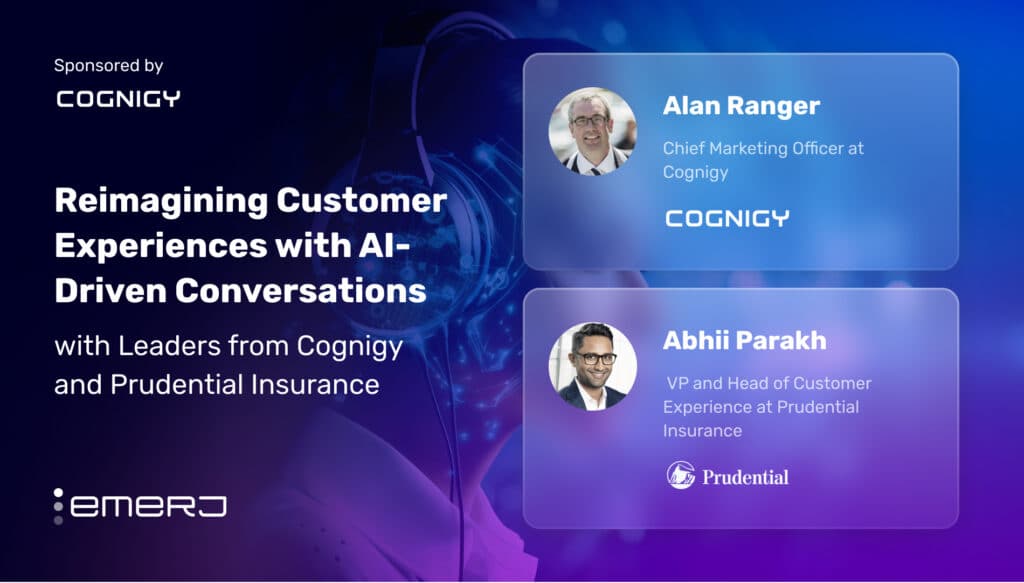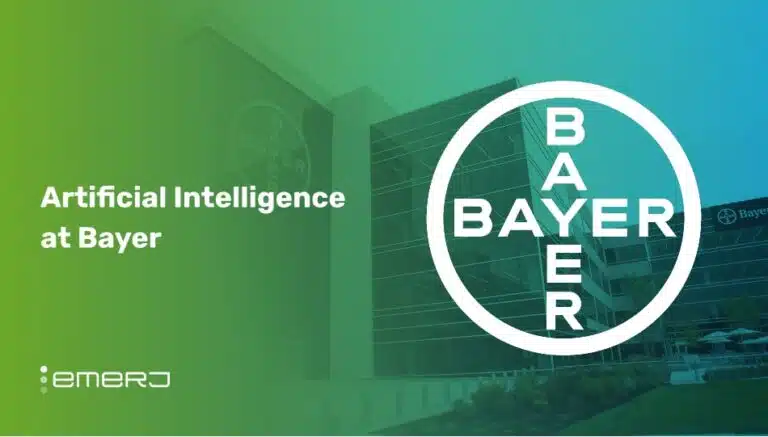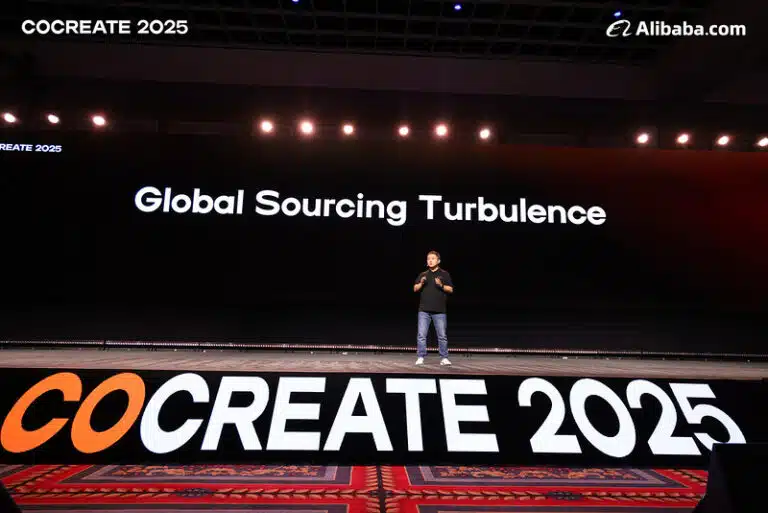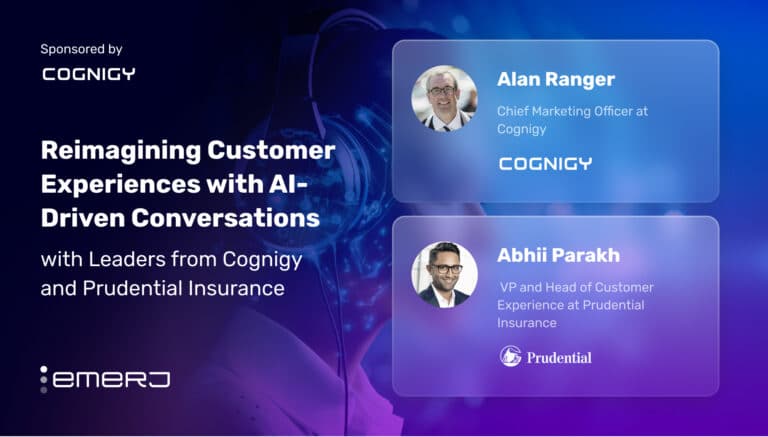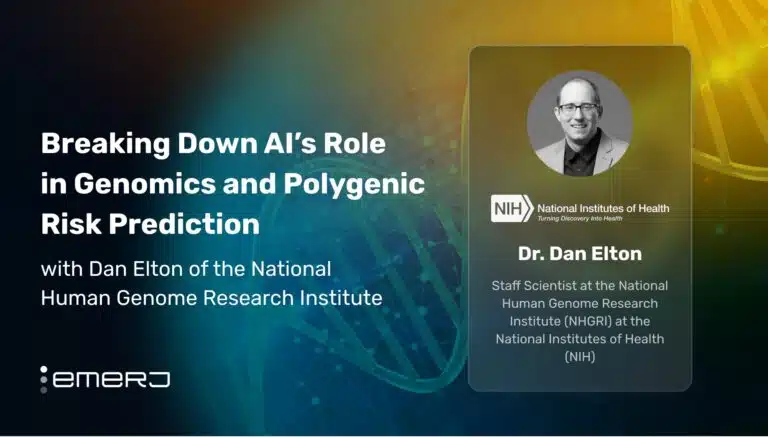This article is sponsored by Cognigy and was written, edited, and published in alignment with our Emerj sponsored content guidelines. Learn more about our thought leadership and content creation services on our Emerj Media Services page.
Repetitive administrative tasks continue to be a significant source of employee burnout across various industries. In healthcare, as Microsoft’s Will Guyman pointed out on a recent episode of Emerj’s ‘AI in Business’ podcast, clinicians perform thousands of clicks per shift to manage documentation and non-clinical tasks, a workload strongly linked to burnout:
“Administrative burden is the first thing that comes to mind. It’s well known that clinicians spend a tremendous amount of time on administrative tasks and non-clinical care tasks. They do about 4,000 clicks per shift, and that really adds up in terms of burnout.”
– Will Guyman, Principal Group Product Manager in Healthcare AI Models at Microsoft
Similar dynamics play out in customer service, where agents routinely handle basic queries, such as password resets or account updates, diverting time and energy from more meaningful and complex interactions. Research by the Harvard Business Review notes that repetitive work is one of the main drivers of disengagement among employees. Automating these routine tasks through AI is becoming essential to improving both productivity and employee well-being.
A 2021 Salesforce study found that 89% of U.S. automation users reported greater job satisfaction, and 84% said they were more satisfied with their company as a result of automation — underscoring the value of reducing repetitive tasks through AI.
Looking ahead, the McKinsey Global Institute projects that activities accounting for up to 30% of hours currently worked across the U.S. economy could be automated by 2030 — a trend accelerated by generative AI.
Emerj recently featured a special series on the AI in Business podcast with Alan Ranger, Chief Marketing Officer at Cognigy, and Abhii Parakh, VP and Head of Customer Experience at Prudential Financial. Respectively, they shed light on how enterprises can move beyond hype by focusing on two key priorities: building scalable, integrated AI systems that can handle enterprise complexity, and striking a balance between automation and human-in-the-loop design to preserve trust and empathy in customer experiences.
Their conversations underscore the importance of solid foundations, such as clean data, system integration, and cross-team alignment, to ensure AI delivers tangible value at scale. This article examines two key insights from their conversations for financial services leaders adopting new and advanced forms of AI at their organizations:
- Prioritizing integration and governance for agentic AI success: Integrating legacy systems, selecting the right partner, and adopting a phased approach to ensure effective governance and success for new AI-driven agentic systems.
- Balancing automation with human oversight in customer interactions: Scaling AI in phases – starting with creative and marketing content, moving into employee productivity – using agentic AI to move from reactive to proactive service while keeping human empathy central.
Prioritizing Integration and Governance for Agentic AI Success
Episode: Rethinking Customer Experiences with AI-Driven Conversations – with Alan Ranger of Cognigy
Guest: Alan Ranger, Vice President at Cognigy
Expertise: Business Development, Strategic Partnership, Marketing
Brief Recognition: Before joining Cognigy as Vice President of Marketing, he led global market development at LivePerson, where he spent six years driving international growth. Earlier in his 30-year career, he held various sales, marketing, and leadership roles across both startups and large enterprise software companies.
Alan explains that while it’s easy to build an AI chatbot that can hold a conversation, it’s much harder to get it to complete fundamental tasks. For that, AI needs to be connected to all the back-end systems a company uses.
Alan cites an example of a large insurance company where all customer calls — tens of millions annually — are first answered by AI. The system:
- Identifies the caller
- Verifies their identity
- Understands the reason for the call
- Retrieves relevant information from legacy systems
- Passes the full context to a human agent for resolution
For instance, if someone calls after a car accident to check if they can get a rental, the AI fetches the details and then hands the call off to a human agent, who is now already equipped with the full context.
“Not only does the AI Agent do a warm handover, it then changes roles and becomes a copilot to support the agent. The AI Agent already has the context of the whole conversation, so it knows exactly what’s been said, what the issue is, and take the next best action.
Again, in a compliance environment, it can make sure that certain statements are read. And then at the end of the call, it does the wrap-up. The human agent checks it, and then the AI agent does all of the updates in those old legacy back-end systems.”
—Alan Ranger, Vice President at Cognigy
Alan says the first step for any company looking to implement AI agents is to choose the right partner. He explains that many companies in the market are simply wrapping an LLM in a wrapper and calling it an AI agent. These tools may look impressive in demos, but they often lack the in-depth enterprise knowledge and scalability required in real-world situations.
He gives the example of a sudden surge in calls, such as if an airport shuts down and 10,000 calls come in at once. Most off-the-shelf tools won’t be able to handle that kind of spike. A good partner, he says, needs to understand enterprise-scale and surge capacity, which is something that can’t be solved by hiring more people.
Beyond scale, Alan highlights the importance of orchestration. That means being able to integrate with legacy systems. He points out that most large enterprises lack modern tech stacks or a single unified platform. Instead, they have different systems, and there’s no plug-and-play AI agent that works with all of them.
The build part addresses that challenge. Alan says a strong platform should come with prebuilt integrations that help shorten time to value. While no system will work seamlessly with every legacy tool out of the box, having a platform designed for enterprise integration can significantly accelerate and streamline the process.
Such a partner, he advises, is exactly what businesses need.
Alan says that for risk-averse companies, a smart first step is choosing a high-volume but simple use case suitable for traditional, rule-based conversational AI. It helps them build internal knowledge, understand integration, and set the stage for more advanced AI.
His key advice is to form an AI Council. These are cross-functional teams that align on ethics, compliance, vendors, and strategy. It keeps the business focused, avoids one-off distractions from flashy demos, and helps get AI solutions into production faster and with fewer roadblocks.
Balancing Automation with Human Oversight in Customer Interactions
Episode: The Future of Customer Experience in Financial Services with Agentic AI – with Abhii Parakh of Prudential Financial
Guest: Abhii Parakh, VP and Head of Customer Experience, Prudential Financial
Expertise: Customer Experience, Marketing Strategy, AI Adoption
Brief Recognition: With over 20 years of experience driving revenue growth, brand relevance, and customer loyalty at Fortune 100 companies, he has spearheaded initiatives that doubled Net Promoter Scores and significantly boosted digital engagement. His expertise spans customer experience strategy, AI-powered engagement, digital product innovation, and organizational change leadership.
Abhii highlights how Prudential has approached AI adoption in phases — beginning with creative and marketing content, moving into employee productivity, and now focusing on customer service transformation. He notes that AI’s power lies not just in automating content generation but in enabling enterprises to synthesize insights from thousands of customer interactions in minutes rather than weeks.
Prudential’s journey demonstrates how agentic AI can shift organizations from reactive to proactive service models:
- Reactive Service: Handling inbound customer problems quickly and with less friction.
- Proactive Service: Anticipating customer needs before they arise, delivering timely support based on historical patterns and real-time feedback.
Abhii emphasizes that this transition is not about replacing humans, but about designing the right balance between humans and automation. AI agents can handle the repetitive and basic queries — such as explaining policy options — while human agents focus on complex, high-stakes interactions requiring trust and empathy:
“The balance between the human touch and the AI conversation is really critical in this moment. Some highly complex tasks require too much context and nuance for me to think that the technology can connect all those dots, and only a human being is able to provide that today.
However, we are fast reaching the point where even those high-complexity tasks may be enabled by AI conversations — sometimes even better than a human can.”
– Abhii Parakh, VP and Head of Customer Experience at Prudential Financial
He also cautions that scaling AI adoption is as much a human challenge as a technological one. Clear goals, leadership buy-in, and giving employees hands-on experience with AI tools are critical to overcoming initial skepticism and accelerating adoption. As he puts it, employees only realize the true value once they see how AI eliminates mundane tasks and frees them for higher-value contributions.
Finally, Abhii stresses the importance of partnership between data teams, technology teams, and business leaders to prepare for the next wave of agentic AI. With every vendor now marketing “AI agents,” enterprises must be discerning — separating the hype from the tools that can truly integrate with legacy systems and scale to enterprise demands.


